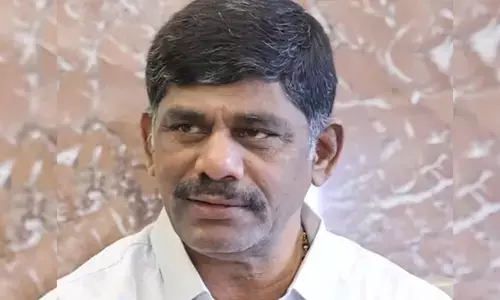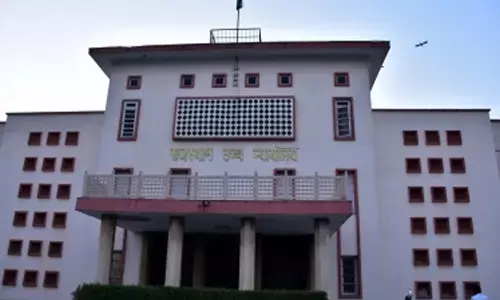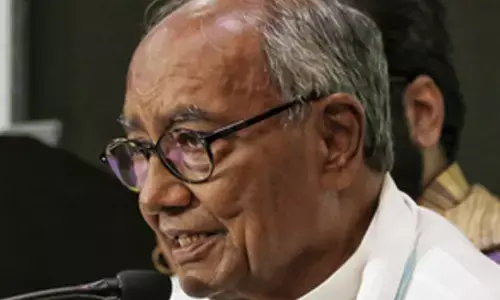Space technology has boosted national development

On the eve of successful launch of the Chandrayan 2.0 Mission, which bagged in Indian space history an eminent space, lawyer and Head, Centre for Aerospace and Defence Laws(CADL), Nalsar University of Law, Prof V Balakista Reddy talked to The Hans India on Indian Space Journey, vision of Dr.Vikram Sarabhai, Father of Indian Space Programme, Chandrayan I and II.
On the eve of successful launch of the Chandrayan 2.0 Mission, which bagged in Indian space history an eminent space, lawyer and Head, Centre for Aerospace and Defence Laws(CADL), Nalsar University of Law, Prof V Balakista Reddy talked to The Hans India on Indian Space Journey, vision of Dr.Vikram Sarabhai, Father of Indian Space Programme, Chandrayan I and II. Also, he spoke about privatisation and legislations regulating activities in the space.
Could you please tell us about yourself and NALSAR's contribution in the domain of Air & Space Law?
I completed my M Phil and PhD in Aerospace Law from Jawaharlal Nehru University, New Delhi in 2000. Since then I am working in the field of Aerospace Law and contributing to various aspects of Aerospace Law. Further, I am also Heading the Centre for Aerospace and Defense Laws (CADL) at NALSAR and launched various unique and innovative programmes in the field of Aerospace and Defence Laws.
Talking about NALSAR, I am happy to inform you that the University has taken a big leap by focusing on the contemporary legal issues about Air & Space Law. It is the only University in India which can proudly reveal the fact that it has offered Special courses in Air & Space Law at UG and PG level and Distance Mode has been able to produce more than 600 students as experts in the same domain. I will be glad to tell you that these students have been catering to the needs of national as well as the international aerospace sector by rendering their services in various capacities such as Legal advisors, legal consultants, Practicing lawyers, in-house counsels in various International & National Law firms. Suffice it to say, NALSAR is the one, and only esteemed law university which has established a dedicated Centre for Air and Space Law under my supervision.
Could you briefly explain about the Indian space journey so far?
Indian space venture started with a humble beginning in the early 1960s. In the Sixties, the efforts of the Indian space programme confined to getting familiar with space technologies and developing technical and organisational infrastructure to develop satellites and satellite launch vehicles. During the Seventies, the effort was primarily geared towards carrying out research and development in a variety of scientific and engineering disciplines for launch vehicles and satellites. During the Eighties, the Indian space programme moved closer to realizing the goal of self-reliance in the use of space technology for national development.
With the launch of the Bhaskara II, SLV-3, APPLE in the early Eighties, the Indian space programme entered the operational stage to provide space services in communications, meteorology, and remote sensing and development of launch vehicles. India entered the Nineties with the launch of more ASLV and PSLV launchers. In the new millennium, the effort was on sending revolutionary GSLV and EDUSAT projects, which are but important milestones in India's ambition of sending a spaceship to the Moon.
In short, over the last five decades, significant achievements have been made by the Indian space programme in the area of space technology which include, (a) building world-class satellites for communications and remote sensing, (b) development of launch vehicles to orbit satellites of mass range of 1000 kg to 2500 kg, (c) launching remote sensing satellites from India with Indian launch vehicles and (d) in reaching the benefits of space technology to improve the quality of life at grassroot levels, thus contributing to several areas of national development.
Could you comment upon the vision of Dr. Vikram Sarabhai, Father of Indian Space Programme? And do you think we have been able to achieve the vision of Dr. Sarabhai?
Dr Vikram A. Sarabhai, Father of Indian Space Programme and Vice-President and Scientific Chairman of the 1st UNISPACE Conference of 1968, while speaking in the Conference said: "There are some who question the relevance of space activities in a developing nation. To us, there is no ambiguity of purpose. We do not have the fantasy of competing with economically advanced nations in the exploration of the Moon or other Planets or manned space flight. But we are convinced that if we are to play a meaningful role nationally, and in the community of nations, we must be second to none in the application of advanced technologies to the real problems of man and society, which we find in our country. Therefore, with the developments such as Mission on Mars, Chandrayan - I, the successful launch of 104 satellites and today's Chandrayan – II has proved more than what Dr.Vikram Sarabhai visualised then.
How do you look at the earlier achievements like Chandrayan and launching of 104 satellites in one go which has also gained commercial attention in the global market?
Yes, I am coming back. Another point is that we performed Chandrayan with the lowest budget compared to other countries' moon mission. Chandrayan inspired the youth of India. Also, it started the space business of India. That is why Chairman of ISRO delightfully stated after the launch that "Chandrayan means India's business in space. We can accept any contract from any country." The year 1992 was important for space business of India because we established ANTRIX separated from ISRO to do business independently. Similarly, the year 2008. Dr Sarabhai's philosophy is not commerce-related. But Dr G.Madhavan Nair is the first chairman of ISRO who comes out from this philosophy and saying about commerce. When I visited ISRO centres earlier, people were delighted to announce that ISRO is doing good business. In a simple way, it is like that your father is expecting some dream about you and you reach a point on surpassing his dream.
With the successful launch of 104 satellites on a single mission by Indian Space Research Organisation (ISRO), India has created a record thereby breaking the previous record by Russia of launching 37 satellites in 2014. This momentous achievement of the Indian space programme has not only caught the attention of the country but also the entire world. This significant achievement by ISRO is another step towards India's ambitious space programme that has earned a reputation of offering a reliable low-cost alternative to existing international players. The Government is nowhere lagging behind in extending its support to the programme thereby making an increase in the current budget as well as announcing plans to send a mission to Venus
Could you highlight the difference between Chandrayan – I and today's ISRO's successful launch of Chandrayan 2.0 which created a history in the field of space technology?
The spacecraft was orbiting around the Moon at a height of 100 km from the lunar surface for chemical, mineralogical and photo-geologic mapping of the Moon. The spacecraft carried 11 scientific instruments built in India, USA, UK, Germany, Sweden and Bulgaria. Chandrayan – 1 discovered traces of water on the moon – a path-breaking discovery in the world of space science. Chandrayan -1 also discovered water ice in the North Polar Region of the Moon. It also detected Magnesium, Aluminium and Silicon on the lunar surface.
Chandrayan 2.0 is an indigenous mission; it aims to find more knowledge about the Moon. Completely unexplored section of the Moon - it's South Polar region. "Through this effort, the aim is to improve our understanding of the Moon -- discoveries that will benefit India and humanity as a whole. These insights and experiences aimed at a paradigm shift in how lunar expeditions are approached for years to come -- propelling further voyages into the farthest frontiers.
"Chandrayaan 2.0 attempts to foster a new age of discovery, increase our understanding of space, stimulate the advancement of technology, promote global alliances, and inspire a future generation of explorers and the scientist. Chandrayan 2.0 will help us gain a better understanding of the origin and evolution of the Moon by conducting detailed topographical studies, comprehensive mineralogical analyses, and a host of other experiments on the lunar surface,"
Given these developments how do you look at the issue of commercialisation of India's space industry?
The Indian space programme has not only achieved considerable self-reliance in space technology for national development but also promotes its commercial utilisation. A mutually rewarding partnership between the Indian space programme and industry has been built over the past three decades. Accordingly, programmes for partnership with the industrial sector are organized under four closely linked fronts.
These are (i) technology transfers from the space programme to industry; (ii) technological consultancy to industry; (iii)utilization of industry's own technological expertise by the space programme; and (iv) services from the industrial sector. Besides, national accomplishments, India could also get recognition in the international arena as one of the major space-faring nations in the world, which in turn opened up global opportunities and demand for Indian services. The Antrix Corporation, the commercial wing of the Indian Space Research Organisation (ISRO), was established in 1992 with the objective of marketing space products and services in India and abroad. It deals with the transfer of technology developed under the Indian space programme to the Indian industry and provides consultancy services. It also coordinates in the exchange of space hardware and software between ISRO and industry involved in the space programme.
In the context of commercialisation and globalisation scenario where does the privatisation of India's space industry stand?
During the last three decades increasing emphasis on reducing governmental budgets worldwide has forced the world's space-faring nations to reassess their civil space programs. Such action requires establishing close working arrangements between government and private industry which facilitate satellite communications, navigation and position location, remote sensing, data processing, support services, land infrastructure etc.
Developing countries like India are hard-pressed to allocate funds for these activities.
Therefore, the need for privatisation of space activities deserves the maximum attention in countries like India, which need these activities even more than their richer counterparts for their national development. A mutually rewarding partnership between the Indian space programme and industry has been built over the past three decades, which brought about a sense of appreciation and confidence from the private sector. The space application sector witnessed tremendous developments with the active involvement of the private sector. There is a huge market to be tapped in India in the field of cable and satellite television. However, it is disheartening to note that because of the lack of an adequate legal framework, India is losing many opportunities in the field of investment in space technology.
A lot has been discussed about the need for space legislation in India at this juncture. What is your take on that?
India, like many other countries, has not enacted any space legislation. Is it required to enact one? Does it need one? Has its absence impeded India's space activities or posed problems in their pursuit? When there are countries, which do not have such legislation, why should India have one? Is it a lawyer's professional law-mania to insist on the framing of a law in every area where none exists? or at any rate, no codified law exists etc., are one can ask ourselves in the context of arguing for a space legislation in India.
Why do we need space legislation in India?
India is a party to all international space treaties, which form the main body of international space law. India has also played a significant role in the adoption of five sets of legal principles by the U.N. General Assembly Resolutions, which provide for the application of international law and promotion of international cooperation and understanding in space activities. It is also under an obligation to give effects to the various rules contained in these norms through the medium of appropriate legislation in the domestic field.
Do you think because of the absence of space legislation, commercialisation and privatisation of space activities are being affected?
In India, space proliferation is going in a big way but there is no comprehensive or specific space law which regulates the commercial activities of space. Space and space-related matters have been regulated not by one legislation but by legal rules belonging to different areas of the domestic law so far. However, the time has come now for the preparation of an appropriate legal framework, keeping in view the recent national and global developments—the active involvement of the private sector and commercialisation of space activities, and the agreements made nationally and globally with various agencies, governments, international and intergovernmental organizations.
On the domestic front, the public-private sector participation in various space programmes, the cable and satellite TV revolution and various court judgments all remind us of the need for space legislation in India














